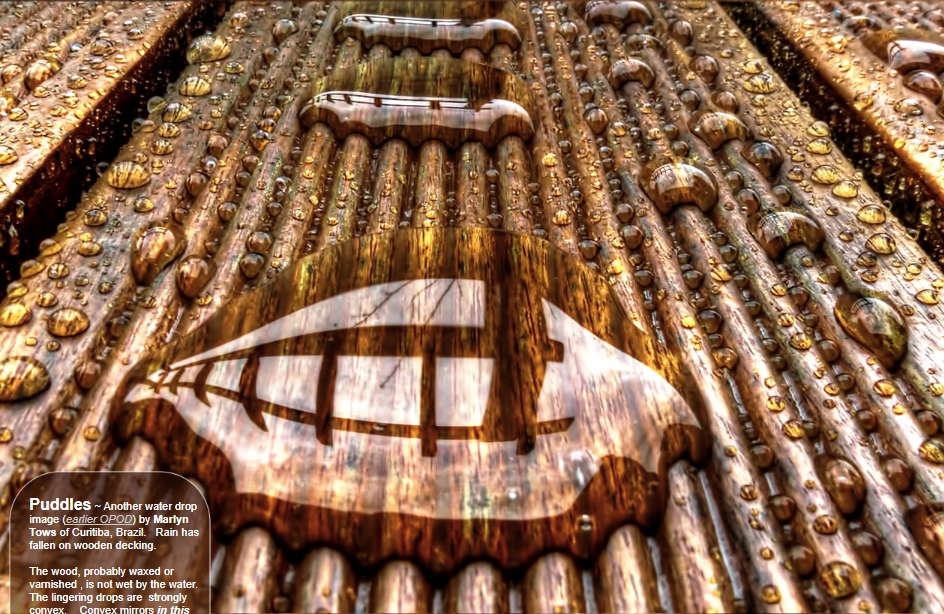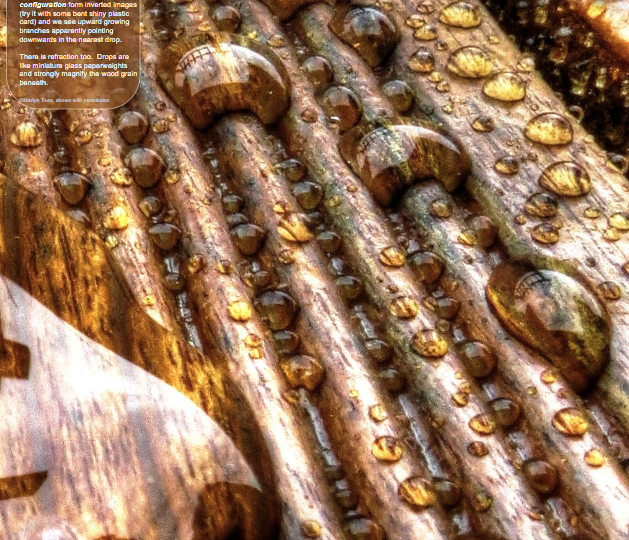Puddle Optics - OPOD
Puddle Optics: Discovering the Hidden Wonders of Raindrops
When rain falls on surfaces like wooden decking, it often creates mesmerizing puddles that offer a glimpse into the fascinating world of puddle optics. In this article, we will explore the captivating phenomena that occur within these puddles and delve into the science behind them.
The Curious Case of Convex Mirrors
Puddles act as convex mirrors, showcasing a unique optical effect. If you have ever observed a bent shiny plastic card, you may have noticed that convex mirrors form inverted images. Similarly, when rainwater lingers on wooden surfaces, the droplets take on a strongly convex shape. As a result, they create inverted images of their surroundings within themselves.
Within these inverted images, something truly intriguing happens. We witness upward growing branches that appear to point downwards in the nearest droplet. This optical illusion occurs due to the inverted nature of the image and the way our brains interpret it. It's a visual trick that never fails to captivate our imagination.
The Magic of Refraction
In addition to the enchanting effect of inverted images, refraction also plays a significant role in puddle optics. Raindrops, acting as miniature glass paperweights, possess the ability to magnify the objects beneath them. When light passes through these droplets, it bends or refracts, revealing intricate details that may otherwise go unnoticed.
One of the most remarkable phenomena resulting from refraction is the magnification of the wood grain beneath the raindrop. As if through a magnifying lens, the intricate patterns and textures of the wooden surface become vividly apparent. It's as if the raindrop unveils a hidden world, allowing us to appreciate the beauty and complexity of nature on a microscopic level.
The Fascination Continues
While we have explored just a few aspects of puddle optics, there is much more to discover. The interplay between light, water, and surfaces presents a vast array of optical phenomena that continue to amaze and intrigue scientists and enthusiasts alike. Here are a few additional aspects to pique your curiosity:
-
Rainbows in Puddles: Puddles can also give rise to stunning miniature rainbows. When sunlight interacts with the raindrops, it undergoes dispersion, separating into its constituent colors. These colors then bounce off the water's surface and create a captivating display of vibrant hues.
-
Mirror-Like Reflections: Puddles provide a perfect canvas for mirror-like reflections. When the surface of the water is still, it acts as a mirror, reflecting the surrounding environment with remarkable clarity. This effect adds an extra layer of beauty and depth to the optical wonders within puddles.
-
Ripple Effects: As raindrops disturb the calm surface of a puddle, mesmerizing ripple effects emerge. These ripples distort the reflected images, creating dynamic patterns that dance across the water's surface. It's a reminder of the constant motion and ever-changing nature of our world.
-
Photography Opportunities: Puddle optics present photographers with a wealth of creative opportunities. The unique reflections, refractions, and patterns found within puddles offer endless possibilities for capturing stunning images that blend artistry and science.
Embracing Wonder in Everyday Moments
Puddle optics remind us to embrace wonder in the seemingly ordinary moments of life. In the midst of a rainy day, we can find beauty and fascination right beneath our feet. By taking a closer look at the interplay between light and water, we uncover hidden worlds and gain a deeper appreciation for the marvels of our natural surroundings.
So, the next time you encounter a puddle after rainfall, take a moment to pause and observe. Peer into its depths, marvel at the inverted images and magnified details, and let yourself be captivated by the magic of puddle optics. In these simple moments, we can unlock a sense of awe and wonder that enriches our lives and deepens our understanding of the extraordinary within the ordinary.

Puddles ~ Another water drop image (earlier OPOD) by Marlyn Tows of Curitiba, Brazil. Rain has fallen on wooden decking.
The wood, probably waxed or varnished , is not wet by the water. The lingering drops are strongly convex. Convex mirrors in this configuration form inverted images (try it with some bent shiny plastic card) and we see upward growing branches apparently pointing downwards in the nearest drop.
There is refraction too. Drops are like miniature glass paperweights and strongly magnify the wood grain beneath.
©Marlyn Tows, shown with permission

Note: this article has been automatically converted from the old site and may not appear as intended. You can find the original article here.
Reference Atmospheric Optics
If you use any of the definitions, information, or data presented on Atmospheric Optics, please copy the link or reference below to properly credit us as the reference source. Thank you!
-
<a href="https://atoptics.co.uk/blog/puddle-optics-opod/">Puddle Optics - OPOD</a>
-
"Puddle Optics - OPOD". Atmospheric Optics. Accessed on November 26, 2024. https://atoptics.co.uk/blog/puddle-optics-opod/.
-
"Puddle Optics - OPOD". Atmospheric Optics, https://atoptics.co.uk/blog/puddle-optics-opod/. Accessed 26 November, 2024
-
Puddle Optics - OPOD. Atmospheric Optics. Retrieved from https://atoptics.co.uk/blog/puddle-optics-opod/.